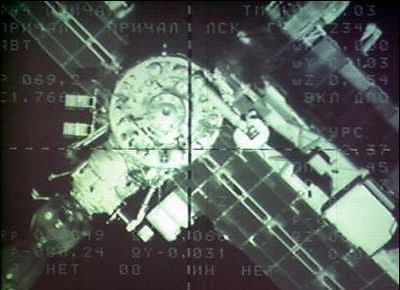Mon, May 17, 2004
ISS Crew Checks Suits, Takes Out Trash
International Space Station Commander Gennady Padalka and NASA
Science Officer and Flight Engineer Mike Fincke eased into a
regular schedule of operations in orbit last week, preparing
spacesuits for checkouts next week and loading trash aboard a
Progress vehicle that will soon depart.
Early in the week, Fincke conducted the second in a series of
battery recharging activities for the US spacesuits. The nickel
metal hydride batteries will be used during a spacesuit dry run
that is scheduled to be conducted next week. Fincke also worked on
the water servicing system of one of the spacesuits' liquid cooling
and ventilation garments. The garments, worn under the spacesuit,
are imbedded with a network of tiny tubes that provide cooling.
Fincke's maintenance work ensured no air bubbles will develop in
that tubing. The spacesuit work is part of preparations and
evaluations for a spacewalk planned for June 10 to replace a Remote
Power Control Module and restore power to a Station Control Moment
Gyroscope.
Both crew members also spent several hours loading trash into
the Progress 13 spacecraft, which is scheduled to be undocked from
the Station at 4:18 a.m. CDT May 24. The next Russian cargo
vehicle, Progress 14, is scheduled to launch May 25 from Kazakhstan
at 7:34 a.m. CDT and dock with the Station at 8:57 a.m. CDT May 27.
Among fresh food, clothes and other supplies to be brought to the
Station aboard Progress 14 are new spacesuit gloves and other
equipment that will be used during the June 10 spacewalk.
Also this week, US flight controllers transmitted a software
upgrade to several onboard computers. The upgrades are part of an
extensive program initiated this year to improve Station software.
They were loaded in four separate Station computers this week: two
external multiplexer/demultiplexers and two S0 Truss MDMs that
operate the systems on the truss.

The crew's scientific work included setting up a camera that
will be used by thousands of middle-school students. The Earth
Knowledge Acquired by Middle School Students (EarthKAM) camera was
set up to operate from a window in the Zvezda Service Module. For
these EarthKAM observations, more than sixty schools and 3,600
students are expected to participate. The EarthKAM program allows
students to research and select photos of sites on Earth to be
taken using the equipment aboard the Station.
Each day, crew members also had some time reserved for continued
Station familiarization and adaptation, as is routine for new
Station crew members during their first two weeks onboard.
Flight controllers are also preparing for a regularly scheduled
reboost of the ISS on Tuesday using the Progress engine for an
11-minute firing that will increase the altitude of the Station by
two statute miles at its apogee.
More News
Its Offerings Are Lighter, Cleaner, and Now Pushing Past 1,000nm on SAF Jet Fuel DeltaHawk’s diesel-powered aircraft lineup has seen incredible upgrades over the last few yea>[...]
The Airplane Experienced A Total Loss Of Engine Power On December 3, 2025, about 1600 central standard time, a Mooney Aircraft Corp. M20K, N57229, was substantially damaged when it>[...]
Make Sure You NEVER Miss A New Story From Aero-News Network Do you ever feel like you never see posts from a certain person or page on Facebook or Instagram? Here’s how you c>[...]
Aero Linx: European Society of Aerospace Medicine (ESAM) As a pan-European, independent forum, it works to promote the safety and health of all persons involved in aviation and spa>[...]
“We are excited to see Wisk achieve this milestone, and I’m so proud of the team that made it possible. The team at Wisk has built advanced technologies across flight c>[...]
 Aero-TV: DeltaHawks Diesel Power Steps Into the Spotlight
Aero-TV: DeltaHawks Diesel Power Steps Into the Spotlight NTSB Prelim: Mooney Aircraft Corp. M20K
NTSB Prelim: Mooney Aircraft Corp. M20K ANN FAQ: Turn On Post Notifications
ANN FAQ: Turn On Post Notifications ANN's Daily Aero-Linx (12.20.25)
ANN's Daily Aero-Linx (12.20.25) Aero-News: Quote of the Day (12.20.25)
Aero-News: Quote of the Day (12.20.25)



